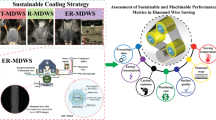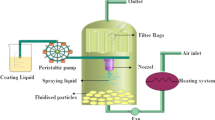Abstract
This paper presents a novel method for improving infeed grinding processes based on the application of continuous variable feed rate (CVFR). Nowadays, infeed cycle configuration is defined by selecting constant feed rates and stock removals for each consecutive stage, normally roughing, finishing, and a final spark-out, for the purpose of achieving required workpiece tolerances in a fixed time while avoiding process limitations and instabilities. CVFR leads to more efficient cycles without the difficulty of defining feed rate and stock removal values. To that end, CVFR has been implemented in a time-domain simulation of infeed grinding processes to analyze theoretically the influence of variation parameters in process forces, workpiece roughness, roundness and size tolerance, or dynamic behavior. Then, tests have been performed to validate the simulation approach, comparing CVFR cycles with equivalent conventional ones. Different types of downward variations for the feed rate have been applied, concluding that grinding processes can be improved with this method regarding productivity and workpiece geometrical and surface tolerances.
Similar content being viewed by others
References
Malkin S (1989) Grinding technology: theory and applications of machining with abrasives. SME, Detroit
Saljé E, Mushardt H, Sherf E (1980) Optimization of short grinding cycles. CIRP Ann 29(2):477–495
Peters J, Aerens R (1980) Optimization procedure of three phase grinding cycles of series without intermediate dressing. CIRP Ann 29:195–200
Amitay G, Malkin S, Koren Y (1981) Adaptive control optimization of grinding. ASME J Ind 103(1):102–111
Xiao G, Malkin S, Danai K (1993) Autonomous system for multi-stage cylindrical grinding. ASME J Dyn Syst Meas Control 115(4):667–672
Xiao G, Malkin S (1996) On-line optimization for internal plunge grinding. CIRP Ann 45(1):287–292
Gallego I (2007) Intelligent centerless grinding: global solution for process instabilities and optimal cycle design. CIRP Ann-Manuf Technol 56:347–352
Hashimoto F, Lahoti G (2004) Optimization of set-up conditions for stability of the centerless grinding process. CIRP An-Manuf Technol 53:271–274
Barrenetxea D, Marquinez JI, Alvarez J, Fernandez R, Gallego I, Maradiaga J, Garitaonandia I (2012) Model-based assistant tool for the setting-up and optimization of centerless grinding process. Mach Sci Technol 16:510–523
Gao Y, Jones B (1992) An optimum size and roundness adaptive control method for the plunge grinding process. J Syst Control Eng 206:107–116
Allason DR, Rowe WB, Chen X, Boyle A (1997) Automatic dwell control in computer numerical control plunge grinding. Proc Inst Mech Eng 211(B):565–575
Malkin S, Koren Y (1984) Optimal infeed control for accelerated spark-out in plunge grinding. J Eng Ind 106:70–74
Dong S, Danai K, Malkin S, Deshmukh A (2004) Continuous optimal infeed control for cylindrical plunge grinding, part 1: methodology. J Manuf Sci Eng 126:327–333
Inasaki I, Karpuschewski B, Lee H (2001) Grinding chatter—origin and suppression. CIRP Ann-Manuf Tech 50:515–534
Barrenetxea D, Marquinez JI, Bediaga I, Uriarte L (2009) Continuous workpiece speed variation (CWSV): model based practical application to avoid chatter in grinding. CIRP Ann-Manuf Tech 58:319–322
Alvarez J, Barrenetxea D, Marquinez JI, Bediaga I, Gallego I (2011) Effectiveness of continuous workpiece speed variation (CWSV) for chatter avoidance in throughfeed centerless grinding. Int J Mach Tools Manuf 51:911–917
Ramos JC, Vinolas J, Nieto FJ (2001) A simplified methodology to determine the cutting stiffness and the contact stiffness in the plunge grinding process. Int J Mach Tools Manuf 41:33–49
Alvarez J, Zatarain M, Barrenetxea D, Ortega N, Gallego I (2013) Semi-discretization for stability analysis of in-feed cylindrical grinding with continuous workpiece speed variation. Int J Adv Manuf Technol 69:113–120
Hecker R, Liang S (2003) Predictive modeling of surface roughness in grinding. Int J Mach Tools Manuf 43:755–761
Gopal AV, Rao PV (2004) A new chip-thickness model for performance assessment of silicon carbide grinding. Int J Adv Manuf Technol 24:816–820
Author information
Authors and Affiliations
Corresponding author
Rights and permissions
About this article
Cite this article
Alvarez, J., Barrenetxea, D., Marquinez, J.I. et al. Continuous variable feed rate: a novel method for improving infeed grinding processes. Int J Adv Manuf Technol 73, 53–61 (2014). https://doi.org/10.1007/s00170-014-5771-1
Received:
Accepted:
Published:
Issue Date:
DOI: https://doi.org/10.1007/s00170-014-5771-1




